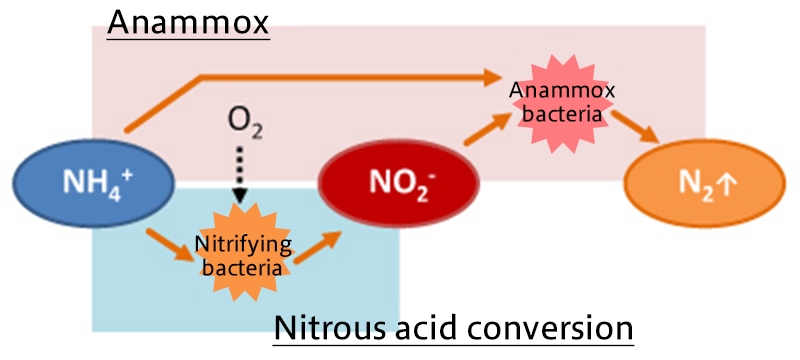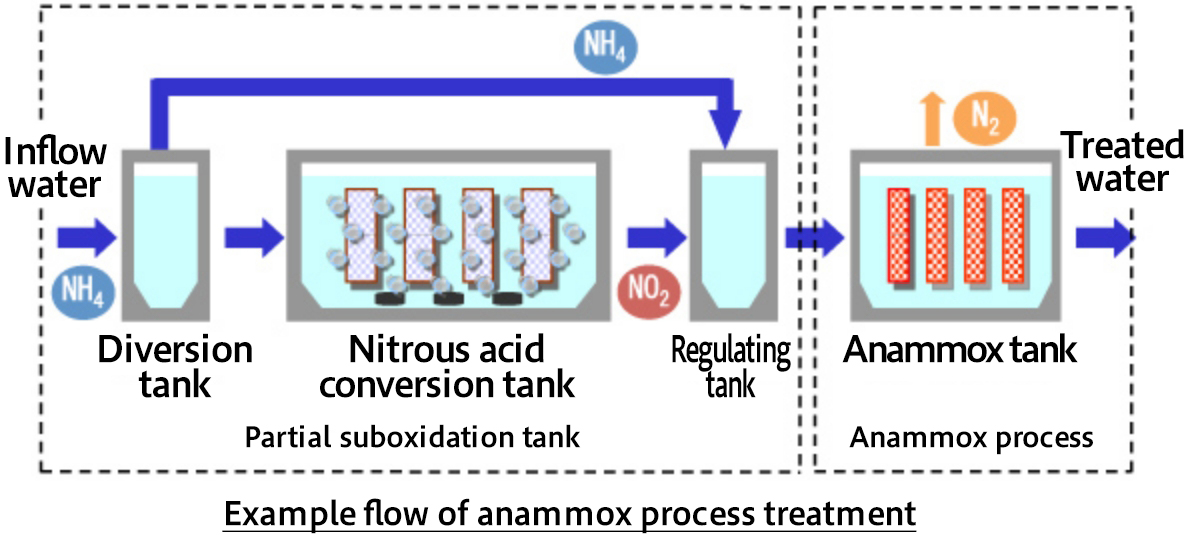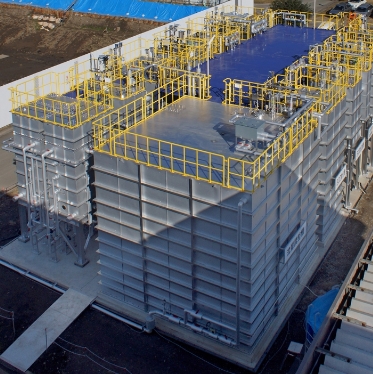
Introducing a low-cost, energy-saving biological nitrogen removal technology. TAKUMA’s anammox technology was adopted for inclusion in the FY2012 B-DASH demonstration project conducted by the Ministry of Land, Infrastructure, Transport and Tourism (Japan).
What is anammox?

Anammox, or anaerobic ammonium oxidation, is an anammox bacteria-driven nitrogen conversion reaction that was discovered during the 1990s. Anammox bacteria are autotrophic bacteria that produce nitrogen gas directly from ammonia and nitrous acid, without requiring any organic matter.
Differences from conventional methods
Conventional nitrogen removal technology (nitrification-denitrification method)

Anammox process

Treatment process
The anammox process is a combination of two treatments: a partial nitrous acid conversion process in which ammonia nitrogen (NH4-N) is converted into nitrite nitrogen (NO2-N), and an anammox process in which the anammox reaction is used to remove the nitrogen. Pre-treatment processes for removing organic matter or suspended solids can be added as necessary, depending on the properties of the wastewater being treated. The anammox process offers treatment performance characterized by a nitrogen removal rate of about 80%.

Features
Reduction in aeration power
Aeration power can be reduced as the anammox process requires half or less the oxygen of the conventional nitrification reaction.
Reduction in chemical costs
Whereas conventional denitrification reactions require the addition of organic matter such as methanol, the anammox process requires no such materials due to the autotrophic nature of anammox bacteria. The result is lower chemical costs.
Less installation space
Use of a fixed-bed carrier makes it possible to maintain a high concentration of anammox bacteria, allowing a high volume load for nitrogen removal. The result is a significant reduction in reaction tank volume and installation space.
Reduction in the amount of excess sludge produced
The anammox process is characterized by significantly lower production of excess sludge since anammox bacteria have a lower growth yield than conventional denitrifying bacteria.
May 2012: Obtained "Selected New Technology (Type 1)", Japan Sewage Works Agency
Fields of application
The anammox process is well suited to treatment of wastewater with a high concentration of nitrogen (ammonia) and a low concentration of organic matter. One example of an application to which it is well suited is individual treatment of returned water (nitrogen removal) at sewage treatment plants that use anaerobic digestion. Although sending return water from digestion tanks that contains ammonia nitrogen in high concentrations (i.e., dehydrated filtrate from digested sludge) back to water treatment facilities raises concerns that the water treatment process will be negatively impacted, individual treatment of return water can help reduce the nitrogen concentration in discharge water and stabilize the treatment process. Specific examples: Dehydrated filtrate from anaerobically digested sludge, methane fermentation supernatant liquor, chemical plant wastewater, landfill leachate, etc.
The Ministry of Land, Infrastructure, Transport and Tourism of Japan Breakthrough by Dynamic Approach in Sewage High Technology (B-DASH) Project
TAKUMA’s anammox technology was adopted for inclusion in the Breakthrough by Dynamic Approach in Sewage High Technology (B-DASH) Project conducted by the Ministry of Land, Infrastructure, Transport and Tourism (Japan), and a demonstration test was executed during FY2012 and FY2013 at a demonstration facility as part of a contract research project commissioned by the Ministry’s National Institute for Land and Infrastructure Management.
“Technology Demonstration Research into Technology for High-efficiency Nitrogen Removal using a Fixed-bed Anammox Process”
| Period | FY2012 and FY2013 |
|---|---|
| Participants | Joint research group consisting of the Kumamoto City, Japan Sewage Works Agency, and TAKUMA CO., LTD. |
| Location | Tobu Waste-water Treatment Plant in Kumamoto City |
| Treatment target | Dehydrated filtrate from anaerobically digested sludge |
| Treatment volume | 50㎥/day |

As a result of the project's findings, guidelines concerning the introduction of the technology were issued in FY2014. “Guidelines on the Introduction of Technology for High-efficiency Nitrogen Removal Using a Fixed-bed Anammox Process (Draft),” issued August 2014 by the National Institute for Land and Infrastructure Management, Ministry of Land, Infrastructure, Transport and Tourism
*The guidelines can be downloaded from the National Institute for Land and Infrastructure Management’s website.
After-sales Services